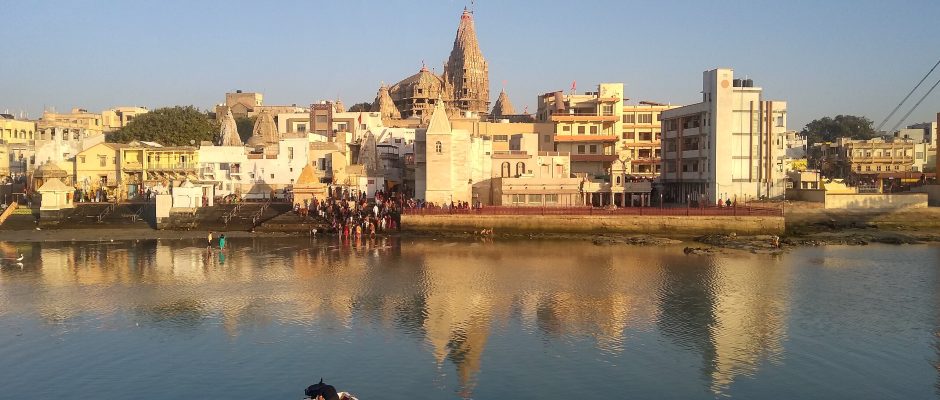Finding Tranquility in the 2,500-Year-Old Temple
Going to the Dwarkadhish Temple on a religious trip is akin to entering a world of heavenly peace. For history buffs and worshipers, Dwarkadhish Mandir Darshan holds immense significance! This holy site is located in the energetic state of Gujarat and is well connected by air, train, and road. Discover the mysteries of the Dwarkadhish Temple, and don’t forget to teach your children about its background, design, and other features. Table of contents: Dwarkadhish Temple: An Ethereal Haven A monument to historical building techniques and dedication to religion is the Dwarkadhish Temple, popularly referred to as Dwarka Temple. Devotees from different religions travel from every corner of the nation to this holy site devoted to Lord Krishna. The temple’s calm ambiance and repetitive prayers create a state of mind that surpasses earthly worries. As you enter the compound for Dwarkadhish Mandir Darshan, the intricate carvings and tall columns articulate different mythology stories. India’s cultural heritage is preserved in this devotional site. This temple is made of soft limestone and has a sanctum and a rectangular vestibule hall with porches on three sides. There are two main gateways: Swarga Dwar, known as the “gate to the heavens,” where pilgrims enter, and Moksha Dwar, known as the “gate to liberation,” where pilgrims exit. This revered sanctuary’s elegance and heavenly aura are so magnificent that mere words cannot contain it. Vajranabh was the great-grandson of Lord Krishna and the last ruler of Dwarka, who constructed the Mandir years ago, which is one of the holy hindu Chaar Dhaams. This temple’s sacred premises have attracted renowned monks, sages, pilgrims, and tourists. Adi Shankara, one of the most esteemed philosophers and theologians, came for Dwarkadhish Mandir Darshan in the 8th century. A plaque honouring his visit can be found inside the temple. The Dwarkadhish Temple’s Architectural Design Dharma followers of Sanatan Dharma hold the main Dwarka temple, Jagat Mandir, in high regard. One of the temple’s most notable characteristics is that it appears to rise directly from the Arabian Sea, maybe alluding to the legend of Lord Krishna stealing ground from the ocean to construct Dwarka. Devotees must mount the approximately fifty stairs atop a slight slope to reach the temple for Dwarkadhish Mandir Darshan. The central holy location of the temple is a five-floor structure with a 43-meter spire that houses the divinity of Lord Krishna. 72 pillars support the main structure and have massive, exquisitely sculpted walls. Engraved on the exterior walls of the Dwarkadhish Temple are artworks depicting famous legends and mythical creatures, all crafted from well-preserved limestone. A 52-yard pennant featuring the Sun and Moon is hoisted atop the magnificent structure, symbolizing that Lord Krishna will live for as many years as they do. Dwarkadhish Temple’s Interiors The interior of the temple is divided into several parts: Garbha Griha – It is the reliquary sanctorum accommodating the deity of Shri Lord Krishna. Only the priest can enter the Garbha Griha area to worship the idol. Ardh Mandapa – The half-open assembly hall is an entryway to the Mukhya Mandap or includes the primary assembly hall. Mandapa – It’s the main assembly hall of the temple and remains open on every side. It has a pyramidal, tiered roof and a miniature bell-like dome adorning it. There are 72 embellished pillars for support and five stories rising over it. Antarala – It’s the tiny antechamber linking Vimana Mandapa to Natya Mandapa. Pradakshina Path – A route surrounding the Garbha Griha, making the holy ritual of circumambulation or Pradakshina easier for the hundreds of worshippers during the Dwarkadhish Mandir Darshan. Legend of the Idol of Lord Dwarkadhish Badana, a genuine devotee of Lord Dwarkadhish, used to visit the sanctum daily from Dakor in Gujarat for Dwarkadhish Mandir Darshan. As her devotion pleased Lord Dwarkadhish, they set off together for Dakor. An infuriated sanctum priest went after Badana, who persuaded the priest in exchange for gold to deter him from reclaiming the idol. The idol was the weight of Badana’s nose ring since Lord Dwarkadhish had just that to spare. It was mentioned that Lord Dwarkadhish had to convince the priest that they would create a replica of the idol. Hence, Dwarka is an abode for that idol. Legend of Rukmini’s Sanctum Dwarka temple was built on land retrieved from the ocean by Lord Krishna. Sage Durvasa once expressed his urge to visit their palace during one of his visits to Krishna and Rukmini. He reportedly asked them to pull a chariot so they could bring him to their palace so he could eat. On the way, Rukmini requested water to satisfy her thirst. When Krishna excavated the infamous hole, the Ganga flowed to where they stood. Durvasa got infuriated by the act of Rukmini not offering water to him and cursed her to stay in the same place. This is how the temple has a sanctum at this location. Spiritual Ventures for the Soul Once you have finished exploring the Dwarkadhish temple, other miracles of Dwarka beckon and the most exquisite thing to start with is Sudama Setu at the base of the temple. Devotees can take a peaceful stroll throughout Gomti Creek toward the nearest beach. If the spirituality of the Dwarkadhish temple nudges you, take a refreshing dip in the pious waters of the nearby Gomati River. During sunset, evening aarti takes place with an enchanting prayer rite to Lord Krishna, which is the best part of your Dwarkadhish Mandir Darshan. You can travel beyond and see the immaculate heaven of Beyt Dwarka. The euphoria of dolphin spotting, water spots, and the serenity of camping and picnics are some of the few things best experienced in this island. A nearby temple is dedicated to Rukmini Devi, the beloved wife of Shri Krishna, which is a must-visit during the Dwarkadhish Mandir Darshan. You may also take a serene walk near Gopi Lake, which has yellow sand, where the disciples of Lord Krishna, Gopis, surrendered their lives. You may also get acquainted with the local traditions and enjoy shopping for conventional handicrafts,









